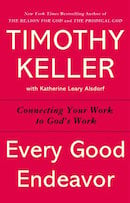Best of Daily Reflections: Mud, Spit, and a Pile of River Rocks
Daily Reflection / Produced by The High Calling
After Jesus said this, he spit on the ground. He made some mud and smeared it on the man’s eyes. Then he said, "Go and wash off the mud in Siloam Pool." The man went and washed in Siloam, which means "One Who Is Sent." When he had washed off the mud, he could see.
John 9:6-7
When Jesus disturbed and penetrated the sand to heal the man born blind, he disturbed and penetrated the hearts of many who watched in wonder at his curious display. No doubt some who witnessed this event scratched their heads in confusion at the carpenter from Nazareth’s odd choice. “I don’t get it,” they mumbled under their breath as they walked away.
But some got it. And their hearts were opened to the possibility that this man was no mere man. He was a healer. His means? Mud and spit—a visceral, gritty salve to open blind eyes. The man bore witness to his neighbors and others who had seen him begging, and, believing, they wanted to find this Jesus.
Jesus did not need to use mud and spit. We know from other passages that he could heal with just a word (Matt. 8:5-13) or a touch (Matt. 8:15). So why the show? I think Jesus knew that some people’s hearts are not captured by a simple word or touch. Some of us need the raw, physical, even artful display of mud and spit.
At our recent Ash Wednesday service, our pastor gave a poignant homily about our need to confess our sins to God and to present our requests to God, but, like Jesus, she did not stop with the spoken word. After preaching the truth from scripture, she invited us to join her on the platform, where she stood beside a pile of large river rocks. We were encouraged to pick up a rock and walk it to the wooden cross that was there. We were encouraged to hold the rock in our hands as we confessed our sins as we set the rock at the foot of the cross. Then we were encouraged to go back to the pile, to select another rock, and another, walking back and forth to the foot of the cross as we presented our requests to God.
The rocks were heavy. They were cold. They were gritty. With each rock, I felt a raw and visceral connection to my sin, my need for God’s help. And as I set each rock before the cross, I felt the weight of that sin and weakness lift a bit. Like Jesus’ work with mud and spit, this display was artful. Would it have been enough to simply receive the preached word and the ashes on my forehead? It might have been enough. But combining the spoken truth with the physical display added weight—both literal and physical—to the message of Ash Wednesday. Our five-year-old son, who had been antsy through most of the service, was suddenly captivated. Walking his rocks up with me, we talked about his sin, his need for God’s help. He was still talking about it that night at bedtime. He would not have remembered anything of the message if it had just been a spoken word, but with the help of the physical component, the message began to take root. He will remember the rocks.
The artists among us know this to be true: words are often not enough. For many, the message only comes alive when it is embodied in a physical form: paint, wood, cement, bronze. Words sometimes pass right over a person’s head, while images are ingrained into minds—and hearts. The ministry of visual or experiential art in worship is often ignored, but it should not be. Just as Jesus combined the physical with the spiritual, so also must we make room for embodied expressions of God’s truth as we worship.
QUESTIONS FOR REFLECTION: We read many examples in the bible of God pairing his message for people with physical objects: a stone (called "Ebenezer"), a burning bush, a model of Jerusalem (Ezekiel 4), etc. What is an object that signifies something God has done in your life? As a ministry leader, how might you incorporate tangible ways to enhance your worship experience?
PRAYER: Creator God, help us to tap into the creativity you have imbued us with as Your image-bearers. Anoint our imagination so that we can worship you more fully and experience You not only with our minds, but with all of our senses. Stir us out of complacent worship by showing us how we might know You better through creative worship practices. Amen.
______________________________
Visual and Creative Arts as Ministry
This article is part of The High Calling series, Visual and Creative Arts as Ministry. At The High Calling, we believe that art creates a space where people may encounter God, opening a door for transformation. Have you felt it? It’s the way the light ripples across water; it’s the way a good story names something within you; it’s the music you dream in the middle of the night that haunts you in the day. God uses beauty to touch us in the deepest places. As image-bearers of the one true God, we are also co-creators with him, made to impact our culture and each other through the art we bring to life. Does this resonate with you? If so, consider sharing these stories via email, Facebook, Twitter, or through your other social media and friendship networks.
Image by Deidra Riggs. Used with permission.






